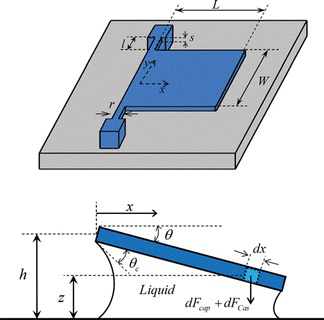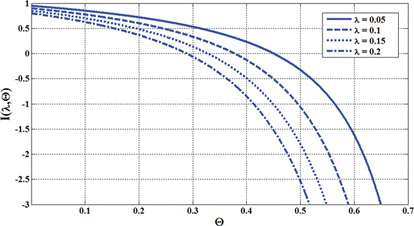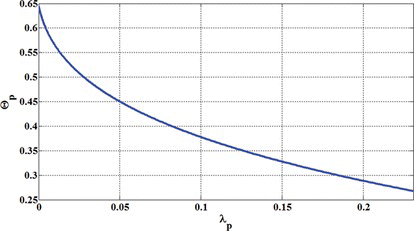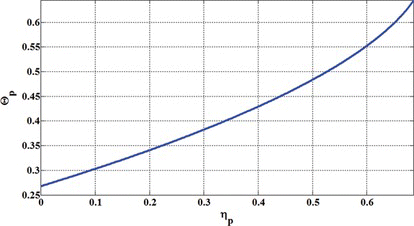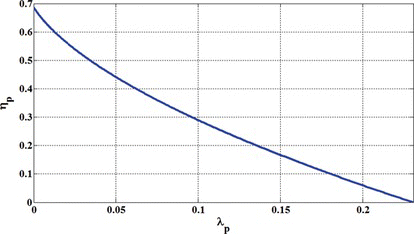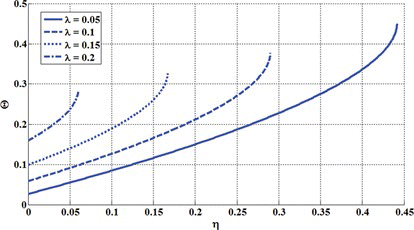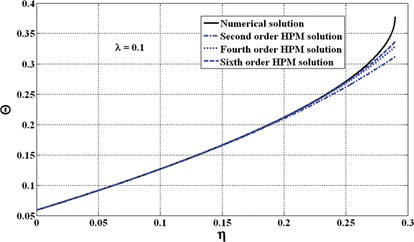Abstract
In the current article the effect of the Casimir force on the static behavior and pull-in characteristics of nano/micromirrors under capillary force is investigated. At the first, the dimensionless equation governing the static behavior of nano/micromirrors is obtained. The dependency of the critical tilting angle on the physical and geometrical parameters of the nano/micromirror and its supporting torsional beams is investigated. It is found that the Casimir effect can considerably reduce the pull-in instability limits of the nano/micromirror. It is also found that rotation angle of the mirror under capillary force highly depends on the Casimir force applied to the mirror. Finally the analytical tool Homotopy Perturbation Method (HPM) is utilized for prediction of the mirror's behavior under combined capillary and Casimir forces. It is observed that a sixth order perturbation approximation accurately predicts the rotation angle and stability limits of the mirror. Results of this article can be used for successful fabrication of nano/micromirrors using the wet etching process where capillary force plays a major role in the system.
NOMENCLATURE
| A wet | = |
wet area of the plate |
| c | = |
speed of light |
| F cap | = |
capillary force |
| F Cas | = |
Casimir force |
| G | = |
shear modulus of elasticity of the beam's material |
| h | = |
initial distance between the mirror and the substrate |
| I p | = |
momentum of inertia of the beams cross section |
| l | = |
length of each torsion beam |
| L | = |
length of mirror |
| P cap | = |
capillary pressure |
| r | = |
width of the torsion beams cross section |
| s | = |
length of the torsion beams cross section |
| U | = |
potential strain energy of the torsion beams |
| U tot | = |
interfacial energy |
| V | = |
potential energy of applied loads |
| W | = |
width of mirror |
| W e | = |
work done by external forces |
| Greek Letters | = | |
| γ | = |
surface energy of the liquid |
| γ LA | = |
liquid-air interfacial tensions |
| γ SA | = |
solid -air interfacial tensions |
| γ SL | = |
solid-liquid interfacial tensions |
| ∏ | = |
total potential energy of the system |
| θ | = |
tilting angle of the mirror |
| θ c | = |
contact angle |
| Θ | = |
dimensionless tilting angle of the mirror |
1. INTRODUCTION
The technology of MEMS devices has experienced a lot of progress recently. Their low manufacturing cost, batch production, light weight, small size, durability, low energy consumption, and compatibility with integrated circuits, makes them extremely attractive (Maluf and Williams Citation1999; Younis Citation2004). Successful MEMS devices rely not only on well developed fabrication technologies, but also on the knowledge of device behavior, based on which a favorable structure of the device can be forged (Chao et al. Citation2006). The important role of MEMS devices in optical systems initiate the development of a new class of MEMS called MicroOptoElectroMechanical Systems (MOEMS). MOEMS mainly include micromirrors and torsional micro-actuators. These devices have found a variety of applications such as digital micromirror devices (DMD) (Hornbeck Citation1991), optical switches (Ford et al. Citation1999), micro scanning mirrors (Bai et al. Citation2007; Dickensheets and Kino Citation1998), optical cross connects (Zavracky et al. Citation1997), and etc.
The existence of a liquid bridge between two objects results in the forming of capillary force (Wei and Zhao Citation2007). The existence of capillary force even in low relative humidity is observed experimentally (Zwol et al. Citation2008). Parallel plate MEMS actuators are conventionally fabricated by forming a layer of a plate or beam material on the top of a sacrificial layer of another material and wet etching the sacrificial layer. In this process, capillary force can be easily formed and in the case of poor design, the structure will collapse and adhere to the substrate. So investigating the effect of capillary force on micromirrors is extremely important in their design and fabrication.
Many researchers investigated the effect of capillary force on MEMS devices. Mastrangelo and Hsu (Citation1993) studied the stability and adhesion of thin micromechanical structures under capillary force, theoretically and experimentally. Moeenfard et al. (Citation2010) studied the effect of capillary force on the static pull-in instability of fully clamped micromirrors. The effects of capillary force on the static and dynamic behaviors of atomic force microscopes (AFM) are widely assessed (Zitzler et al. Citation2002; Li and Peng Citation2006; Jang et al. Citation2004). Recently, the instability of torsional MEMS/NEMS micro-actuators under capillary force was investigated by Guo et al. (Citation2009).
When the size of a structure is sufficiently small, Casimir and van der Waals forces play an important role and in the case of poor design, can lead to the collapse of the structure. VdW force is the interaction force between neutral atoms and it differs from covalent and ionic bondings in that it is caused by correlations in the fluctuating polarizations of nearby particles (Xie Citation2009). Casimir force is understood as the longer distances range analog of the vdW force, resulting from the propagation of retarded electromagnetic waves, whose distance ranges from a few nanometers up to a few micrometers (Gusso and Delben Citation2007). An important feature of the Casimir effect is that even though it is quantum in nature, it predicts a force between macroscopic bodies (Bordag et al. Citation2001). This makes the Casimir force relevant in N/MEMS (Zhao et al. Citation2003).
Zhao et al. (2003) discussed the Casimir force induced adhesion in MEMS. Tahami et al. (Citation2009) discussed Pull-in Phenomena and Dynamic Response of a Capacitive Nano-beam Switch by considering Casimir effect. Casimir effect on the pull-in parameters of nanometer switches has been studied by Lin and Zhao (Citation2005a). They (Lin and Zhao Citation2005b) also studied Nonlinear behavior of nano-scale electrostatic actuators with Casimir force. Ramezani et al. (Citation2007; Citation2008) investigated the two point boundary value problem of the deflection of nano-cantilever subjected to Casimir and electrostatic forces using analytical and numerical methods to obtain the instability point of the nanobeam. Modeling and simulation of electrostatically actuated nano-switches under the effect of Casimir forces have been studied by Mojahedi et al. (Citation2009). Sirvent et al. (Citation2009) theoretically studied pull-in control in capacitive microswitches actuated by Casimir forces using external magnetic fields. Effect of the Casimir force on the static deflection and stiction of membrane strips in MEMS have been studied by Serry et al. (Citation1998). Guo and Zhao (Citation2004) discussed the effect of Casimir force on the pull-in of electrostatic torsional actuators. But statical behavior and pull-in of single sided nano/micromirrors under effect of capillary and Casimir forces has not been investigated. So in this article, the combined effect of Casimir and capillary forces on the tilting angle and stability of torsional nano/micromirror is studied. In this study, HPM is used as a perturbational based analytical tool.
Perturbation methods have been used to analytically solve the nonlinear problems in MEMS. Younis and Nayfeh (Citation2003) investigate the response of a resonant microbeam to an electric actuation using the multiple-scale perturbation method. Abdel-Rahman and Nayfeh (Citation2003) used the same method to model secondary resonances in electrically actuated microbeams. Since perturbation methods are based upon the assumption that there is a small parameter in the equations, they have some limitations in problems without involvement of small parameters. In order to overcome this limitation a new perturbational based method, namely Homotopy Perturbation Method (HPM) was developed by He (Citation2000). His new method takes full advantages of the traditional perturbation methods and homotopy technique. Homotopy perturbation method has also been used for solving the nonlinear problems encountered in N/MEMS. For example, Moeenfard et al. (Citation2011) used HPM to model the nonlinear vibrational behavior of Timoshenko micobeams. Mojahedi et al. (Citation2010) applied the HPM method to simulate the static response of nano-switches to electrostatic actuation and intermolecular surface forces. But so far no analytic solution has been presented to model the behavior of nano/micromirrors.
In the current article, the equations governing the static behavior of rectangular nano/micromirrors are obtained using the minimum potential energy principle. Then pull-in parameters of nano/micromirrors under the effect of Casimir and capillary forces are investigated. At the end, the tilting angle of a nano/micromirror under Casimir and capillary forces is calculated both numerically and analytically using HPM.
2. THEORETICAL MODEL
The contact angle θ c for a liquid drop shown in Figure a is determined by the balance among the liquid-air (LA), solid–air (SA), and solid-liquid (SL) interfacial tensions, which are denoted by γ LA , γ SA and γ SL , respectively (Guo et al. Citation2009). At the equilibrium state, Young's equation (Knospe and Nezamoddini Citation2009) is satisfied as follows.
Figure 1 (a) Contact angle of a droplet at a solid-liquid interface (b) Liquid bridge between two parallel plates (color figure available online).

At the equilibrium state, the energy of the system shown in Figure b is (Fortes Citation1982):
The capillary force can be obtained from the interfacial energy as follows.
As a result, the capillary pressure underneath the plate is
Using the obtained equation for capillary pressure, the capillary force applied to the differential surface element of the micromirror shown in Figure is
Furthermore the differential Casimir force applied to a differential surface element of the mirror shown in Figure is (Liu et al. Citation2010):
The minimum total potential energy principle (Rao Citation2007) is utilized here to obtain equilibrium equation and to investigate the stability of the equilibrium points. The total potential energy of the system can be divided into two parts: the potential strain energy of the torsion beams and the potential energy of applied loads which is equal to the minus of work done by external forces.
The potential strain energy of system can be calculated as:
In this equation, G is the shear modulus of elasticity of the beam's material, l is length of each torsion beam and I p is the polar momentum of inertia of the beams cross section which can be calculated using equation (12) (Huang Citation2004).
The variation of U would be as
The total external work done on nano/micromirror to rotate it from angle θ to angle θ + δθ can be calculated as follows.
At equilibrium points, equation (9) must be satisfied. So by performing the integration in equation (14), the equilibrium equation is obtained as follows.
Performing the second variation operator on equation (8) and using equilibrium equation yields:
According to minimum total potential energy principle an equilibrium point is stable when δ2∏ > 0 and is unstable when δ2∏ < 0 (Gambhir Citation2004). So the stability condition is reduced to:
Finding η from equation (16) and substituting it in equation (20) leads to:
Figure shows the function I(λ, Θ) versus Θ at some values of λ.
An equilibrium point is stable if I(λ, Θ) > 0 and unstable if I(λ, Θ) < 0. It is observed that at certain value of Θ called Θ P , which relates to the pull-in state, I(λ, Θ) becomes zero. When Θ < Θ P , I(λ, Θ) would be positive and the resulting equilibrium point is stable and when Θ > Θ P , I(λ, Θ) would be negative and the resulting equilibrium point is unstable.
At the pull-in state, in addition to the equilibrium equations, the following equation is also satisfied.
Equations (Equation16) and (Equation22) can be solved simultaneously for finding η and λ at the pull-in. The results are as follows.
In equations (23) and (24), λ P , η P and Θ P are the values of λ, η and Θ at pull-in, respectively. Figures and shows the values of pull-in angle versus λ P and η P , respectively. It is observed that with increasing the value of λ P the pull-in angle of the mirror is reduced, while with increasing the η P , the pull-in angle of the mirror is increased.
By eliminating Θ P between equations (23) and (24), η P can be obtained versus λ P as plotted in Figure . It is observed that by increasing the dimensionless Casimir force applied to the mirror λ P , the mirror resistance to the capillary force is reduced and pull-in occurs at lower values of η. In fact this figure shows that Casimir force can significantly reduce the maximum allowable value for η and as a result, the stability limits of the nano/micromirror are reduced. In addition it can be concluded that even in the absence of capillary force, Casimir force can lead to the occurrence of pull-in. So, in order to have a successful and stable design for nano/micromirrors fabricated using wet etching process where capillary force plays a major role, the inequalities given in equation (25) have to be satisfied.
In order to investigate the mirror's behavior under combined capillary and Casimir loading, the dimensionless rotation angle has been plotted versus η in Figure .
It is observed that by increasing the value of η the rotation angle of the nano/micromirror is increased, but the maximum value of η at pull-in, highly depends on the value of λ and it is verified that by increasing λ, the maximum allowable value for λ is reduced. Furthermore it is concluded that at a constant η, larger values of λ would lead to larger values for stable equilibrium angle.
3. ANALYTICAL SOLUTION OF EQUILIBRIUM EQUATIONS
In this section, we try to find the value of the rotation angle of the nano/micromirror analytically in terms of η and λ. For this purpose, the analytical tool, HPM is utilized.
The linear part of equation (16) can be found by using Taylor series expansion of the equilibrium equation (16) as follows.
Now, the homotopy form is constructed as follows.
![]()
In equation (28), ![]() is the homotopy form and P is an embedding parameter which serves as perturbation parameter. When P = 1, the homotopy form would be the same as the equilibrium equation and when P = 0, homotopy form would be the linear part of equilibrium equation. The value of the dimensionless rotation angle Θ can also be expanded in terms of the embedded parameter P as follows.
is the homotopy form and P is an embedding parameter which serves as perturbation parameter. When P = 1, the homotopy form would be the same as the equilibrium equation and when P = 0, homotopy form would be the linear part of equilibrium equation. The value of the dimensionless rotation angle Θ can also be expanded in terms of the embedded parameter P as follows.
Substituting equation (29) into homotopy form yields:
![]()
The Taylor series expansion of right hand side of equation (30) in terms of P would be as

Since the homotopy form must be unified with zero, the coefficients of all powers of P must be zero. This, leads to the following equations.
With solving equations (32) to (35), the parameters Θ i 0 ≤ i ≤ 3 are found as follows.
The value of Θ can be found by substituting Θ i 0 ≤ i ≤ 3 and P = 1 in equation (29). In Figure the results of the numerical simulations is compared with those of analytical HPM results for the special case of λ = 0.1. It is observed that HPM closely approximates the rotation angle of the mirror. Obviously increasing the order of perturbation approximation would lead to more precise results, but increasing the order of the perturbation approximation more than 6 will not improve the accuracy of the obtained response significantly. As a result, a sixth order perturbation approximation used in HPM can precisely predict the nano/micromirror behaviour under the combined effects of capillary and Casimir force.
4. CONCLUSION
The dimensionless equilibrium equation of the nano/micromirror under capillary force was obtained considering Casimir force. The dependency of the critical tilting angle on the instability numbers defined in the article was investigated. Results show that neglecting the Casimir effect on the static equilibrium of nano/micromirrors under capillary force may lead to considerable error in predicting stability limits of the mirror and can lead to an unstable design.
It was observed that rotation angle of the mirror due to capillary force highly depends on the Casimir effect applied to the mirror. HPM was utilized to analytically predict the rotation angle and stability limits of the nano/micromirrors. It was found that a sixth order perturbation approximation can accurately estimate the rotation angle of the mirror due to capillary and Casimir loading. The presented results in this article can be used for stable design and fabrication of nano/micromirrors using wet etching process where the gap between the mirror and the underneath substrate is less than a few micrometers and as a result, both capillary and Casimir forces have significant effects on the system.
REFERENCES
- Abdel-Rahman , Eihab M. and Ali H. Nayfeh . 2003 . Secondary resonances of electrically actuated resonant microsensors . Journal of Micromechanics and Microengineering 13 ( 3 ): 491 – 501 .
- Bai , Yanhui , John Tze Wei Yeow , and Brian Wilson . 2007 . A characteristic study of micromirror with sidewall electrodes . International Journal of Optomechatronics 1 ( 3 ): 1323 – 1328 .
- Bordag , Michael , Umar Mohideen , and Vladimir Mostepanenko . 2001 . New developments in the Casimir effect . Physics Report 353 : 1 – 205 .
- Chao , P. C. P. , Cheng Chiu , and Chieh Tsai . 2006 . A novel method to predict the pull in voltage in a closed form for micro-plates actuated by a distributed electrostatic force . Journal of Micromechanics and Microengineering 16 ( 5 ): 986 – 998 .
- Dickensheets , David and Gordon Kino . 1998 . Silicon-micromachined scanning confocal optical microscope . Journal of Microelectromechanical Systems 7 ( 1 ): 38 – 47 .
- Ford , Joseph , Vladimir Aksyuk , David Bishop , and James Walker . 1999 . Wavelenghth add-drop swiching using tilting micromirrors . Journal of Lightwave Technology 17 ( 5 ): 904 – 911 .
- Fortes , Manuel. 1982 . Axisymmetric liquid bridges between parallel plates . Journal of Colloid and Interface Science 88 ( 2 ): 338 – 352 .
- Gambhir , Murary. 2004 . Stability Analysis and Design of Structures . Berlin : Springer .
- Guo , Jian and Yapu Zhao . 2004 . Influence of van der Waals and Casimir forces on electrostatic torsional actuators . Journal of Microelectromechanical Systems 13 ( 6 ): 1027 – 1035 .
- Guo , Jian , Li Zhou , and Yapu Zhao . 2009 . Instability analysis of torsional MEMS/NEMS actuators under capillary force . Journal of Colloid and Interface Science 331 ( 2 ): 458 – 462 .
- Gusso , Andre and Guilherme Delben . 2007 . Influence of the Casimir force on the pull-in parameters of silicon based electrostatic torsional actuators . Sensors and Actuators A 135 ( 2 ): 792 – 800 .
- He , Jihuan. 2000 . A coupling method of a homotopy technique and a perturbation technique for non-linear problems . International Journal of Non-Linear Mechanics 35 ( 1 ): 37 – 43 .
- Hornbeck , Larry. 1991 . Spatial light modulator and method. US Patent: 5,061,049.
- Huang , Jian , A. Q. Liu , Z. L. Deng , Q. X. Zhang , J. Ahn , A. Asundi . 2004 . An approach to the coupling effect between torsion and bending for electrostatic torsional micromirrors . Sensors and Actuators A 115 ( 1 ): 159 – 167 .
- Jang , Joonkyung , George Schatz , and Mark Ratner . 2004 . Capillary force in atomic force microscopy . Journal of Chemical Physics 120 ( 3 ): 1157 – 1160 .
- Knospe , Carl and Ali Nezamoddini . 2009. Capillary force actuation. Journal of Micro-Nano Mechatronics 5 (3): 57–68.
- Lin , Wen and Yapu Zhao . 2005a . Casimir effect on the pull-in parameters of nanometer switches . Microsystem Technologies 11 ( 2–3 ): 80 – 85 .
- Lin , Wen and Yapu Zhao . 2005b . Nonlinear behavior for nanoscale electrostatic actuators with Casimir force . Chaos, Solitons and Fractals 23 ( 5 ): 1777 – 1785 .
- Li , Xide and Yun Peng . 2006 . Investigation of capillary adhesion between the microcantilever and the substrate with electronic speckle pattern interferometry . Applied Physics Letters 89 : 234104 .
- Liu , Haipeng , Shiqiao Gao , Shaohua Niu , and Lei Jin . 2010 . Analysis on the adhesion of micro-comb structure in MEMS . International Journal of Applied Electromagnetics and Mechanics 33 ( 3–4 ): 979 – 984 .
- Maluf , Nadim and Kirt Williams . 1999 . An Introduction to Microelectromechanical Systems Engineering. , Second Edition , MicroelectromechanicalSystems (MEMS) Series . Boston , London : Artech House Inc .
- Mastrangelo , Carlos and C. H. Hsu . 1993 . Mechanical stability and adhesion of microstructures under capillary forces-part 1: Basic theory . Journal of Microelectromechanical Systems 2 ( 1 ): 33 – 43 .
- Mastrangelo , Carlos and C. H. Hsu . 1993 . Mechanical stability and adhesion of microstructures under capillary forces-part 2: Experiments . Journal of Microelectromechanical Systems 2 ( 1 ): 44 – 55 .
- Moeenfard , Hamid , Mohammad Kahrobaiyan , and Mohammad Ahmadian . 2010 . Application of the extended Kantorovich method to the static deflection of microplates under capillary force. ASME International Mechanical Engineering Congress and Exposition, IMECE2010:39517.
- Moeenfard , Hamid , Mahdi Mojahedi , and Mohammad Ahmadian . 2011 . A homotopy perturbation analysis of nonlinear free vibration of timoshenko microbeams . Journal of Mechanical Science and Technology 25 ( 3 ): 279 – 285 .
- Mojahedi , Mahdi , Hamid Moeenfard , and Mohammad Ahmadian . 2009 . A new efficient approach for modeling and simulation of nano- switches under combined effects of intermolecular surface forces and electrostatic actuation . International Journal of Applied Mechanics 1 ( 2 ): 349 – 365 .
- Mojahedi , Mehdi , Hamid Moeenfard , and Mohammad Ahmadian . 2010 . Analytical solutions for the static instability of nano-switches under the effect of Casimir force and electrostatic actuation. ASME International Mechanical Engineering Congress and Exposition, 63–69.
- Ramezani , Asghar , Aria Alasty , and Javad Akbari . 2007 . Pull-in parameters of cantilever type nanomechanical switches in presence of Casimir force . Nonlinear Analysis: Hybrid Systems 1 ( 3 ): 364 – 382 .
- Ramezani , Asghar , Aria Alasty , and Javad Akbari . 2008 . Analytical investigation and numerical verification of Casimir effect on electrostatic nanocantilevers . Microsyst Technol 14 ( 2 ): 145 – 157 .
- Rao , Sinjiresu. 2007 . Vibration of Continuous Systems . New Jersey : John Wiley & Sons .
- Serry , Michael , Dirk Walliser , and Jordan Maclay . 1998 . The role of the Casimir effect in the static deflection and stiction of membrane strips in microelectromechanical systems (MEMS) . Journal of Applied Physics 84 ( 5 ): 2501 – 2506 .
- Sirvent , Raul , Ovando Palomino , and Gregorio Cocoletzi . 2009 . Pull-in control due to Casimir forces using external magnetic fields . Applied Physics Letters 95 ( 5 ): 051909 .
- Tahami , Farid , Hamed Mobki , Ali Janbahan , and Ghader Rezazadeh . 2009 . Pull-in phenomena and dynamic response of a capacitive nano-beam switch . Sensors & Transducers Journal 110 ( 11 ): 26 – 37 .
- Wei , Zheng and Yapu Zhao . 2007. Growth of liquid bridge in AFM. Journal of Physics D: Applied Physics 40 (14): 4368–4375.
- Xie , Guoxin , Jianning Ding , Shuhai Liu , Wei Xued , and Jing Luob . 2009 . Interfacial properties for real rough MEMS/NEMS surfaces by incorporating the electrostatic and Casimir effects–a theoretical study . Surface and Interface Analysis 41 ( 4 ): 338 – 346 .
- Younis , Mohammad and Ali Nayfeh . 2003 . A study of the nonlinear response of a resonant microbeam to an electric actuation . Nonlinear Dynamics 31 ( 1 ): 91 – 117 .
- Younis , Mohammad. 2004 . “Modeling and Simulation of Microelectromechanical Systems in Multi-Physics Fields.” PhD thesis, Virginia Polytechnic Institute and State University.
- Zavracky , Paul , Sumit Majumber , and Nicol McGruer . 1997 . Micromechanical switches fabricated using nickel surface micromachining . Journal of Microelectromechanical Systems 6 ( 1 ): 3 – 9 .
- Zitzler , Lothar , Stephan Herminghaus , and Frieder Mugele . 2002 . Capillary forces in tapping mode atomic force microscopy . Physical Review B 66 ( 15 ): 1554361 – 1554368 .
- Zhao , Yapu , Lisen Wang , and Tao Yu . 2003 . Mechanics of adhesion in MEMS–a review . Journal of Adhesion Science and Technology 17 ( 4 ): 519 – 546 .
- Zwol , Van , George Palasantzas , and Jeff Dehosson . 2008 . Influence of roughness on capillary forces between hydrophilic surfaces . Physical Review E 78 ( 3 ): 03160 (1–6).
